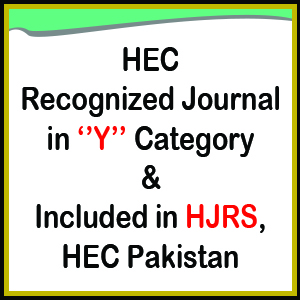Structural Changes in Employment Diversification in Pakistan: Assessing the Role of Sectoral Employment Elasticities in Employment Generation
DOI:
https://doi.org/10.47067/reads.v7i2.347Keywords:
Employment Elasticity, Employment Diversification, Full-Time, Part-TimeAbstract
Employment growth (part-time and full-time) in Sub-sectors of economic activity is not only determined by the output growth in this sector but the time lag is also involved, in addition to this the wage elasticity of employment is also critical in determining employment diversification and labor mobility between sectors, varied widely in different sectors of the economy. This paper endeavors to illustrate the role of part-time and full-time employment elasticity among sectors along with employment diversification. Furthermore, the empirical analysis is carried out on time series data for 1990 to 2019. By utilizing Seemingly Unrelated regression and by estimating wage elasticity of employment with modified two factor Cobb-Douglas function for full time and part-time employment, the results have been illustrated, by carefully considering the reliability, consistency, and accuracy of the findings, this study demonstrates an increased sectoral output tends to enhance employment in respective sectors. For the manufacturing sector and construction sector, both sectoral output and total output were found to have comparable responses that suggest employment for both sectors tends to increase in line with the output. Therefore, the conclusions of the study establish that an effective way to enhance employment is to create flexibility in the wages as an efficient approach to enhance sectoral employment.
References
Alimova, G. A. (2021). Employment, Unemployment and Poverty Reduction. The American Journal of Interdisciplinary Innovations and Research, 3(04), 84-89.
Ali-Yrkkö, J. (2005). Impact of public R&D financing on employment (No. 980). ETLA Discussion Papers.
Arif, B. W. (2012). The nexus between labor reallocation and sectoral productivities in Pakistan: 1980 to 2007. International Journal of Peace and Development Studies, 3(5), 85-91.
Bora, D. (2020). DETERMINANTS OF LIVELIHOOD DIVERSIFICATION AMONG RABHA TRIBES OF ASSAM: A CASE STUDY. PalArch's Journal of Archaeology of Egypt/Egyptology, 17(7), 4058-4069.
Canagarajah, S., Newman, C., & Bhattamishra, R. (2001). Non-farm income, gender, and inequality: evidence from rural Ghana and Uganda. Food policy, 26(4), 405-420.
Card, D., & Krueger, A. B. (1992). Does school quality matter? Returns to education and the characteristics of public schools in the United States. Journal of political Economy, 100(1), 1-40.
Christiano, L. J., & Eichenbaum, M. (1992). Current real-business-cycle theories and aggregate labor-market fluctuations. The American Economic Review, 430-450.
Dekker, R., De Grip, A., & Heijke, H. (2002). The effects of training and overeducation on career mobility in a segmented labour market. International Journal of Manpower.
Dey, S. (2018). The role of employment diversification in reducing vulnerability to poverty among marginal and small-holder agricultural households in India. Margin: The Journal of Applied Economic Research, 12(1), 88-112.
Ellis, F., & Mdoe, N. (2003). Livelihoods and rural poverty reduction in Tanzania. World development, 31(8), 1367-1384.
Evangelista, R., & Savona, M. (2003). Innovation, employment and skills in services. Firm and sectoral evidence. Structural Change and Economic Dynamics, 14(4), 449-474.
Haggblade, S., Hazell, P. B., & Reardon, T. (Eds.). (2007). Transforming the rural nonfarm economy: Opportunities and threats in the developing world. Intl Food Policy Res Inst.
Hou, X. (2010). Challenges for youth employment in Pakistan: are they youth-specific?. The Pakistan Development Review, 193-212.
Islam, I., & Nazara, S. (2000). Estimating Employment Elasticity for the Indonesian Economy. Jakarta, Indonesia: International Labour Office.
Jiun, C. Y., & Nga, J. L. (2011). Economic growth, employment elasticity and poverty: A case of Malaysia. Prosiding Persidangan Kebangsaan Ekonomi Malaysia Ke VI, 469.
Jouili, T. A., & Khemissi, F. M. (2019). Impact of economic diversification on graduates' employment. International Journal of Advanced and Applied Sciences, 6(3), 35-39.
Kimmel, J., & Kniesner, T. J. (1998). New evidence on labor supply:: Employment versus hours elasticities by sex and marital status. Journal of Monetary Economics, 42(2), 289-301.
Künn-Nelen, A., De Grip, A., & Fouarge, D. (2013). Is part-time employment beneficial for firm productivity?. ILR Review, 66(5), 1172-1191.
Liew, H. P. (2017). Health and well-being of middle age Indonesians: An application of seemingly unrelated regression (SUR) models. Health Policy and Technology, 6(3), 322-327.
Lucas Jr, R. E., & Rapping, L. A. (1969). Real wages, employment, and inflation. Journal of political economy, 77(5), 721-754.
McElwee, G., & Bosworth, G. (2010). Exploring the strategic skills of farmers across a typology of farm diversification approaches. Journal of farm management, 13(12), 819-838.
Montalvo, J. G., & Ravallion, M. (2009). The pattern of growth and poverty reduction in China. The World Bank.
Nasir, N., Yasmin, F., & Safdar, N. (2021). Employment Diversification Patterns in Pakistan: Empirical Assessment Revisited. Review of Economics and Development Studies, 7(1), 77-90.
Nasir, Z. M. (2000). Earnings differential between public and private sectors in Pakistan. The Pakistan Development Review, 111-130.
Oluwasola, O. (2015). Vegetable production, livelihood diversification and employment generation in Oyo State, Nigeria. Journal of Agricultural Science, 7(8), 165.
Rahut, D. B., Ali, A., Kassie, M., Marenya, P. P., & Basnet, C. (2014). Rural livelihood diversification strategies in Nepal. Poverty & Public Policy, 6(3), 259-281.
Ravallion, M. (2011). A comparative perspective on poverty reduction in Brazil, China, and India. The World Bank Research Observer, 26(1), 71-104.
Reddy, P. A. (2016). Impact of Education on Employment Diversification among Tribal youth (Doctoral dissertation).
Senadza, B. (2012). Non?farm income diversification in rural Ghana: Patterns and determinants. African Development Review, 24(3), 233-244.
Shaheen, R., Shabir, G., Faridi, M. Z., & Yasmin, F. (2015). Determinants of female employment status in Pakistan: A case of Sahiwal District. Pakistan Journal of Commerce and Social Sciences (PJCSS), 9(2), 418-437.
Sheikh, K. H., Iqbal, Z., & Akhtar, M. R. (1992). Short-Term Employment Functions in Manufacturing Industries: An Empirical Analysis for Pakistan [with Comments]. The Pakistan Development Review, 31(4), 1267-1277.
Suryadarma, D., Suryahadi, A., & Sumarto, S. (2013). Sectoral growth and job creation: Evidence from Indonesia. Journal of International Development, 25(4), 549-561.
Xiao, J., Boschma, R., & Andersson, M. (2018). Industrial diversification in Europe: The differentiated role of relatedness. Economic Geography, 94(5), 514-549.








